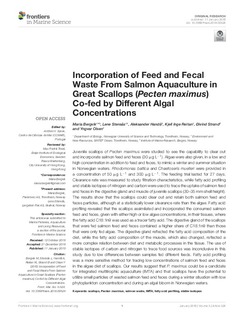| dc.contributor.author | Bergvik, Maria | |
| dc.contributor.author | Stensås, Lene | |
| dc.contributor.author | Handå, Aleksander | |
| dc.contributor.author | Reitan, Kjell Inge | |
| dc.contributor.author | Strand, Øivind | |
| dc.contributor.author | Olsen, Yngvar | |
| dc.date.accessioned | 2019-01-22T20:39:43Z | |
| dc.date.available | 2019-01-22T20:39:43Z | |
| dc.date.created | 2019-01-02T22:43:40Z | |
| dc.date.issued | 2019-01-11 | |
| dc.identifier.citation | Frontiers in Marine Science, 11 January 2019 | nb_NO |
| dc.identifier.issn | 2296-7745 | |
| dc.identifier.uri | http://hdl.handle.net/11250/2581858 | |
| dc.description.abstract | Juvenile scallops of Pecten maxiumus were studied to see the capability to clear out and incorporate salmon feed and feces (30 µg L-1). Algae were also given, in a low and high concentration in addition to feed and faeces, to mimic a winter and summer situation in Norwegian waters. Rhodomonas baltica and Chaetoseris muelleri were provided in a concentration of 50 µg L-1 and 300 µg L-1. The feeding trial lasted for 27 days. Clearance rate was measured to study filtration characteristics, while fatty acid profiling and stable isotopes of nitrogen and carbon were used to trace the uptake of salmon feed and feces in the digestive gland and muscle of juvenile scallops (30–35 mm shell height). The results show that the scallops could clear out and retain both salmon feed and feces particles, although at a statistically lower clearance rate than the algae. Fatty acid profiling revealed that the scallops assimilated and incorporated the consumed salmon feed and feces, given with either high or low algae concentrations, in their tissues, where the fatty acid C18:1n9 was used as a tracer fatty acid. The digestive gland of the scallops that were fed salmon feed and feces contained a higher share of C18:1n9 than those that were only fed algae. The digestive gland reflected the fatty acid composition of the diet, while the fatty acid composition of the muscle, which also changed, reflected a more complex relation between diet and metabolic processes in the tissue. The use of stable isotopes of carbon and nitrogen to trace food sources was inconclusive in this study due to low differences between samples fed different feeds. Fatty acid profiling was a more sensitive method for tracing low concentrations of salmon feed and feces in the algae diet of scallops. Our results suggest that P. maximus could be a candidate for integrated multi trophic aquaculture (IMTA) and that scallops have the potential to utilize small particles of wasted salmon feed and feces during a winter situation with low phytoplankton concentration and during an algal bloom in Norwegian waters. | nb_NO |
| dc.description.abstract | Incorporation of feed and fecal waste from salmon aquaculture in great scallops (Pecten Maximus) co-fed by different algal concentrations | nb_NO |
| dc.language.iso | eng | nb_NO |
| dc.rights | Navngivelse 4.0 Internasjonal | * |
| dc.rights.uri | http://creativecommons.org/licenses/by/4.0/deed.no | * |
| dc.subject | scallops | nb_NO |
| dc.subject | Pecten maximus | nb_NO |
| dc.subject | salmon waste | nb_NO |
| dc.subject | IMTA | nb_NO |
| dc.subject | fatty acid profiling | nb_NO |
| dc.subject | stable isotopes | nb_NO |
| dc.title | Incorporation of feed and fecal waste from salmon aquaculture in great scallops (Pecten Maximus) co-fed by different algal concentrations | nb_NO |
| dc.type | Journal article | nb_NO |
| dc.type | Peer reviewed | nb_NO |
| dc.description.version | publishedVersion | nb_NO |
| dc.rights.holder | © 2019 Bergvik, Stensås, Handå, Reitan, Strand and Olsen. This is an open-access article distributed under the terms of the Creative Commons Attribution License (CC BY). The use, distribution or reproduction in other forums is permitted, provided the original author(s) and the copyright owner(s) are credited and that the original publication in Frontiers in Marine Science is cited, in accordance with accepted academic practice. No use, distribution or reproduction is permitted which does not comply with these terms. | nb_NO |
| dc.source.volume | 5 | nb_NO |
| dc.source.journal | Frontiers in Marine Science | nb_NO |
| dc.identifier.doi | 10.3389/fmars.2018.00524 | |
| dc.identifier.cristin | 1649039 | |
| cristin.unitcode | 7566,6,0,0 | |
| cristin.unitname | Miljø og nye ressurser | |
| cristin.ispublished | true | |
| cristin.fulltext | original | |
| cristin.qualitycode | 1 | |

